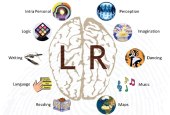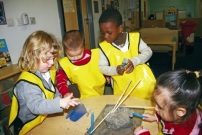How about Playing as an Innovative Instructional and Learning Strategy?
To me, the word innovation brings to mind words like fresh, unique, or new; much like the pleasing aroma of a freshly brewed pot of coffee stirs up all of our senses.

So, my question today is can something old – like the French Press circa 1930 – be innovative. Well…maybe if something old is used in a new way, it can be thought of as innovative…Like the time my family went camping. We were challenged with trying to figure out a way to brew good coffee without a stove – after some thought, we turned to the old French Press. This kitchen appliance is not a traditional camping utensil, but let’s get one thing straight, it worked like a champ, and we had the best coffee in the campground!
Hmmm…so, is play in the academic setting innovative? If we apply this same thought process used in my camping example, then yes, play can be innovative. Relax, take a sip of your coffee and read my rationale – I will keep it simple like a cup of coffee black.
then yes, play can be innovative. Relax, take a sip of your coffee and read my rationale – I will keep it simple like a cup of coffee black.
Rushton (2011) shared many early childhood educators are already adept at modifying their practices to meet the needs of their diverse learners. He discussed four brain principles that posit the importance of educating the whole child. Again, not a new concept; however, the methods used to accomplish this employ current research to modify current approaches, moving them to the innovative end of the spectrum.
Principle 1
Just as the “Venti half white mocha, half cafe vanilla, ez ice, with 2 shots pour appigato style (over the top) with whipped cream and caramel drizzle frappachino” coffee order is unique, so is the organization of every brain. This means using a variety of resources is necessary to ensure all learners have what they need.
If phonics is the desired skill, activities such as sandboxes, magnetic doodle pads, and play-dough traditionally used for play can be used to trace and write letters with fingers as the children make the letter/sound correspondence. Children who are beyond this skill can use the same materials and form words or sentences.
Principle 2
When the barista froths the milk into a beautiful foamy head it transforms into something amazing – kind of like the metamorphosis from caterpillar to butterfly – the brain does the same thing. It develops and changes over time, adapting to the environment.
In the classroom, teachers must detect these changes the way one detects the mouthwatering aroma of a freshly opened package of coffee. Adapting the curriculum to meet the ever-changing needs of the student requires the teacher to explore ways to broaden the purpose of existing materials (Rushton, 2011). For example, as a child demonstrates mastery of most phonemic awareness skills, the student can begin to engage in developing their own rhyming patterns and discussing their reasoning (metacognition) behind their choices. As the child’s brain develops and the teacher innovatively adapts the play rhyme routine to incorporate higher order thinking skills, the child transforms; rising with the sweet steam of a cappuccino, taking flight like a butterfly.
Principle 3
How do you feel on Sunday morning when you realize a loved-one has thoughtfully prepared a heavenly cup of coffee for you? Everything is positive, you feel important, and you now have the power to take on the world!
Well…that is what teachers do – teachers thoughtfully prepare learning experiences that are innovative and meaningful for their students – the students feel safe, loved, content, and supported in the choices they make to guide their new personal learning endeavor (with the direction and approval of their teacher, when needed). Moving from teacher-centered towards student-centered instruction encourages the students to construct their own meaning as it relates to their life and academic experience (Bruner, 1977; Vygotsky, 1930). The use of multimedia simulation games are a terrific way to use resources traditionally used for play as a way to engage the learner in a dynamic learning opportunity relevant and similar to the student’s real world (Verhoeven, Schnotz, & Paas, 2009).
Principle 4
One of my favorite feelings is letting the smooth, cool coffee beans run through my fingers…taking in the bold aroma and feeling their silky exterior awakens my senses. Then I toss them in the grinder and press down to commence the grinding process. I watch the beans whir around and around until they become a velvety powder that I will use to make the perfect cup of coffee, my cup of coffee, but if I want to or need to, I have enough to share with someone else.
A young learner needs to engage in real-world experiences that are relevant to them. They must have opportunities to explore and create with their hands. This type of learning immerses them into the content like a spoon dipping into a cup of coffee. As it stirs the imagination, there is a deep understanding and appreciation for the outcome. Perhaps there are questions about making changes or improvements, perhaps the student needs to talk with someone to clarify their thoughts or seek validity…the options are endless if a person is given the opportunity to explore on their own terms with regards to their brain’s development.
Cheers!
Alas, although my cup is empty … my heart is full of joy and excitement to know that even though there is an incredible paradigm shift in education, there still innovative educators who recognize not all innovations require a plug – more often than not, innovation is adapting what is already in existence and making it better. Play is not new, but it can be used innovatively in multitudes of ways in order to optimize learning for all students.
References:
Bruner, J. (1977). The process of education. Cambridge, MA: Harvard University Press.
Rushton, S. (2011). Neuroscience, early childhood education and play: We are doing it right! Early Childhood Education Journal, 39, 89-94. doi:10.1007/s10643-011-0447-z
Verhoeven, L., Schnotz, W., & Paas, F. (2009). Cognitive load in interactive knowledge instruction. Learning and Instruction, 19(5), 369–375.
Vygotsky, L (1930). Mind and society. Retrieved from http://www.cles.mlc.edu.tw/~ cerntcu/099-curriculum/Edu_Psy/EP_03_New.pdf
Photo Credits:
Black Coffee retrieved from: www.sparklemarkets.wordpress.com
Butterfly Foam Coffee retrieved from: www.misxhdwallpapers.com
Coffee in Hands retrieved from: www.shutterstock.com
Confident Students retrieved from: www.gloucesternurseryschool.co.uk
Dog Coffee retrieved from: www.theguardian.com
Empty Cup retrieved from: lamponastand.com
Exploring Students retrieved from: elevatelanguage.com
French Press retrieved from: www.franklygoodcoffee.com
Heart Coffee Cups retrieved from: www.inoholics.com
Observant Teacher retrieved from: www.express.co.uk
Unique Brain retrieved from: myuniquebrain.com










I enjoyed drinking it all in, Sheryl. I’ll take the vent half white mocha, half cafe vanilla, ez ice, with 2 shots please! And I can’t wait to serve up some play with my kids.
LikeLiked by 1 person
I know play might not be as innovative as a wiki, but I tried to apply it to my context, and I am just not sure how to incorporate some of these technologies at the kiddo level – I would love to see more involvement with tech, but I do not want it to be relegated to simply using tech for standard purposes – I am really thinking hard about adapting some of these great resources/tools to promote the P21 & critical thinking/problem solving skills in my little learners 🙂 I am glad you enjoyed and I will get that order right up (the play that is- as for the coffee…you are on your own – lol!)
LikeLike